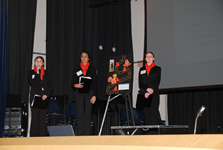
High school students from Fairfax County, Va., are using social media and other methods to help discourage their peers from driving while distracted by cell phones.
A team of three students from George C. Marshall High School were named winners of the “Orange Cones. No Phones.” High School Safety Challenge on Dec. 9. The contest, sponsored by Transurban-Fluor, asked Fairfax County high school students to develop a marketing plan that would discourage young drivers from texting while behind the wheel.
Transurban-Fluor is currently working on the largest highway construction project in the country, adding high-occupancy toll lanes on the Capital Beltway.
“Because we have so much construction going on and safety is such a top priority to us and to all of our project partners, we launched a safety campaign aimed to reduce distracted driving specifically within our work zones,” said Michelle Holland, public affairs manager for the Capital Beltway HOT Lanes Project with Transurban.
“When we first launched the campaign, there was an increase in traffic incidence on the Capital Beltway in Virginia, so we wanted to step up and do our part,” Holland said. Holland said Transurban-Fluor decided to target high schools in Fairfax County because students there were directly impacted by the construction.
“We had a special program targeted to young student drivers, drivers that are just getting their license or have only been driving for a short while, and that’s where we really came up with the concept of having a marketing competition and reaching out to the students to see if they could come up with campaigns and programs that would get our message out to their peers,” Holland said.
The winning team, composed of George Marshall students Ritika Jain, Christine Greve, and Jenny Felter, stood out from other competitors because of their use of social media to target their peers.
“We thought that social media would have a great impact on teenagers because they use Facebook and Twitter and all of those social networking sites every day, and so advertising on those websites would get the word out about the promotion plan and campaign,” said Jain.
The three students conducted a survey to better understand their target market before choosing a course of action. After processing their results, they proposed modifying Transurban-Fluor’s Facebook and Twitter pages so they would be more appealing to students.
“It’s also a low-cost alternative, as we have a very limited budget,” said Holland. Participants in the contest were given a $5,000 budget to work with.
The George Marshall team also proposed a competition amongst students to develop the best YouTube video commercial for the “Orange Cones. No Phones,” campaign, with an iPod touch prize as an incentive.
“We created out own sub-slogan, which is ‘Is one glance worth a chance?’ to target high school students a little better,” added Felter, who said the original advertisements appealed more to older drivers.
The team will have the opportunity to put its strategy to test during the spring semester.
“This really is a phenomenal opportunity to take what these students are learning in the classroom and give them a real case study situation where we’re not just talking about maybes or if we coulds on a project,” said Jen Hendrickson, a teacher at George Marshall. “This is a real $5,000 that’s going to be spent. … I think the more opportunities we give students to do this, the more prepared they’re going to be for the workplace and be able to get the jobs that are in this industry.”
“It made the numbers more real, so it made us really think about the exact things that would go into the plan and how exactly we’d carry that out,” said Jain.
The teams were scored on their use of a timeline and the budget, the organization of their presentation, creativity, and how easily the idea could be implemented within the budget parameters.
Other teams came up with the ideas such as orange rubber bracelets with the campaign’s slogan on them, with the thought that students would see them on their wrists every time they put their hands on the steering wheel. Some proposed having assemblies and bringing in experts to discuss the construction and statistics about the dangers of distracted driving.
“We had four schools that competed, and every team really did a great job,” said Holland, who added that the winning team’s use of social media tipped the scales in their favor.
“The pinnacle of their campaign was working within social media, because their research showed over three-fourths of the teenagers they were surveying used a social networking website at least once a day,” Holland said. Holland added that the personalized slogan was a nice touch.
“The sub-tagline [was] targeted towards their audience … so we thought that showed some creativity as well and some ownership of their team,” said Holland.
The team will begin putting their plan into action in January. They will be supervised by Transurban-Fluor officials, and the process of enacting their idea will count as internship credit for them.
- New film fights negative perception of teachers - September 16, 2011
- Textbook-free schools share experiences, insights - September 7, 2011
- Social websites are latest sources for plagiarized material - September 1, 2011


